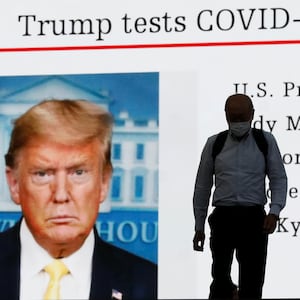News that President Donald Trump and first lady Melania Trump had contracted the coronavirus may have sent shockwaves through the nation’s capital as it awoke Friday morning. But for those who worked for the president, the surprise was that it had taken this long to get to this point.
The White House may house some of the most important figures in government. But for months, the testing protocols to screen potentially infectious individuals have been more lax than the president’s aides present to the public.
Olivia Troye, a former senior adviser for the White House coronavirus task force, said in an interview Friday morning that “the majority of people who work in” the Eisenhower Executive Office Building, which houses most offices for White House staffers, “weren’t getting tested daily” when they “went into the West Wing for meetings.”
“I knew this because you have to be on the list to get tested and I know from talking to them,” Troye recalled. “It was going to be a time constraint and a resource constraint… These were more junior staffers who weren’t seeing the president, but from what we know about how this virus spreads, that… wasn’t keeping people safe.”
As of Friday morning, it remained unclear just how Trump and the first lady contracted COVID-19. Their diagnosis came on the heels of news that the president’s top aide Hope Hicks had tested positive and self-isolated on the ride on Air Force One on Wednesday night. But there was no evidence or confirmation that Hicks had passed the disease to her boss, or vice versa.
Nevertheless, the news called into question exactly what type of protocols the Trump administration had put in place to ensure that the deadly virus would not enter the White House compound or spread once in there. (While the EEOB is a separate building from the White House, aides frequently walk between the two.)
Two individuals familiar with the matter said that after National Security Adviser Robert O’Brien tested positive for the virus July 27, the White House implemented a new testing policy that said all officials and staffers in the Eisenhower Executive Office Building agree to random coronavirus testing. It marked the first time the White House made it mandatory for employees to get tested, despite several individuals testing positive before that date. But, as outlined in a memo The Daily Beast previously obtained, there were still holes in the plan: Not every official was tested every day.
“They basically picked names out of a hat,” one official said.
Under the testing regimen, the “failure to report to testing” would be “considered a refusal to test,” while an individual could defer testing “based on a compelling need.” Exceptions included those who had teleworked for more than 30 days or planned to in the following two weeks, employees on approved leave or on official travel, or people who were not in the immediate vicinity of the building during testing hours.
There were, officials said, other problems with the testing protocols. For starters, staffers in the EEOB said they have been concerned about the accuracy of the tests administered—swab tests with near immediate results. And one other EEOB official said that while not everyone in the building has been required to work from the office, some individuals who experienced symptoms over the last several months were able to stay at work before securing a time to be tested.
At the White House, those entering the compound had reportedly been required to take Abbott point-of-care swab tests. But scientists said those have mixed results and it’s unclear what tests are being administered now. Over time, the universe of those subjected to testing has been decreased to those who work closely with the president. The White House does not mandate the wearing of face masks either.
The administration’s testing protocol for those invited to join the president on Air Force One has also struck many as seriously flawed. According to a congressional aide, the White House didn’t always make guests isolate after getting the test that is required in order to go on the plane, meaning that a guest could get tested and then go about their business—risking exposure—before boarding. “It didn’t inspire confidence,” said the aide.
In response to an inquiry regarding Troye's comments in this story, White House spokesperson Judd Deere said, “The president takes the health and safety of himself and everyone who works in support of him and the American people very seriously.” He noted that White House Operations works closely with the president’s physician and the White House Military Office on “limiting COVID-19 exposure to the greatest extent possible both on complex and when the President is traveling.”
“All those in close proximity to the president are tested beforehand,” Deere said. “Per CDC guidelines, face coverings are recommended.”
In the wake of the Trumps’ positive tests, on Friday morning, Melania Trump’s chief of staff, Stephanie Grisham, told The Daily Beast that “all East Wing staff continues to telework.”
Troye, a longtime Republican who also worked as a counterterrorism adviser to Vice President Mike Pence, decried the culture of the Trump White House, instilled from the top down, of frequently disregarding public-safety and pandemic-era guidelines while at work.
“We should be protecting the president and the White House. We shouldn’t be sitting on top of each other in the Situation Room in meetings, like we were for so long,” she said. “It was a frustrating thing to watch and happen because there are still people on the White House staff who I know very well who don’t take it seriously. You walk into the West Wing, there are signs saying you should be wearing masks, but hardly anybody followed the protocol. And even when you did wear a mask, it felt awkward.”
“I’m actually surprised that it took this long,” she added.
-- with reporting by Sam Brodey










